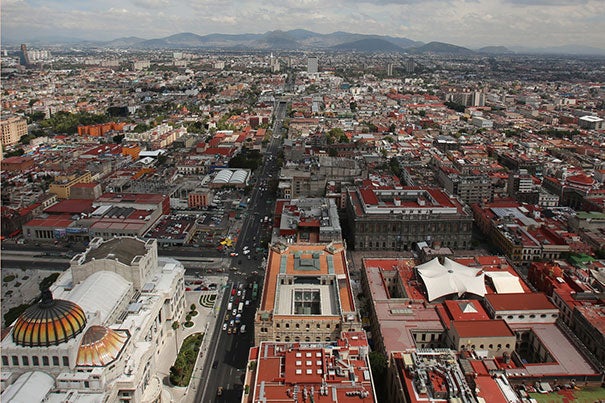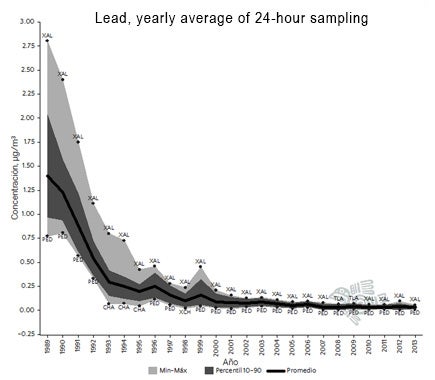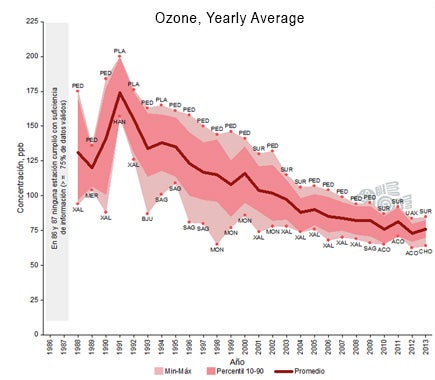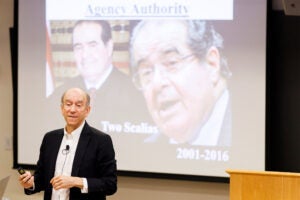
Air quality in Mexico City is influenced by the bowl-like valley it sits within, surrounded by pollution-trapping mountains like those in this 47-story view (photo 1). Heavy traffic accounts for most of the air pollution in this megacity of 22 million residents (photo 2). Yet it also has the largest bike-sharing program (photo 3) in Latin America — one of many attempts to improve the city’s environment and quality of life.
Ned Brown/Harvard Staff
Coming up for air
Mexico City, Harvard alliance to study health changes after two decades of major environmental upgrades
Fifth in a series on Harvard’s deepening connections to Mexico.
MEXICO CITY — Sometimes you’ve got to hit bottom to battle your way back up.
In 1992, the United Nations cited Mexico City as having the worst air quality in the world, with so much pollution that birds sometimes dropped dead in mid-flight. The sprawling megacity contained a swirl of pollutants, including lead, ozone, and particulates. Ozone alone contributed to 1,000 premature deaths a year and 35,000 hospitalizations.
The city’s location in a valley ringed by mountains made air quality worse. Pollution from cars and industry got trapped under thermal air inversions.
Mexican writer Carlos Fuentes jokingly called the nation’s capital “Makesicko City.” Poet and essayist Octavio Paz also noted the burdens of life there. “I walk and do not move forward,” he wrote. “I am surrounded by city. I lack air.”
Growing up in Mexico City amid the worst pollution, “I got pneumonia twice a year,” recalled Harvard-affiliated physician Daniel Palazuelos, co-founder and chief strategist of the Partners In Health project in Chiapas, Mexico.
On the heels of the U.N.’s pronouncement, however, officials in Mexico City acted fast. They required catalytic converters on automobile engines, eliminated lead from gasoline, closed down or moved air-polluting industries, and improved mass transit.
Douglas W. Dockery, who chairs the Department of Environmental Health at the Harvard T.H. Chan School of Public Heath (HSPH), said, “The good news is that there have been very substantial improvements in air quality in the past 25 years.” In the decade following 1990, for example, levels of airborne lead dropped 90 percent. Levels of sulfur dioxide dropped 70 percent.
Dockery is an international authority on the health effects of air pollution, and on the effects of air quality regulations on public health and economies.
A lot is known about air pollution in Mexico City, but little is known about the long-term effects of public policies designed to alleviate it. “That’s the missing piece of the puzzle,” said Enrique Cifuentes, a principal research scientist at HSPH.
Mexico City, Harvard allied
Over the next five years, an alliance between Harvard researchers and the city’s health and environmental officials will evaluate the health and economic benefits derived from two decades of air-quality improvements. They will start by examining 80 health data points from the city’s 16 “delegations,” or neighborhoods. Cifuentes said that Mexico City’s officials “have a very strong system of data collection.”
Cifuentes works in the Department of Environmental Health at HSPH, which will be ground zero for establishing the alliance’s architecture. Five years of proposed steps so far include university courses at Harvard and in Mexico; summer fellowships; spring and winter projects that draw Harvard students south and Mexican students north; a Harvard field office in Mexico; and collaborating pairs of bi-national researchers.
“They will work together and learn from each other,” in an equal partnership between Harvard and Mexico City, said Cifuentes. “We are building a team.” All of that will play out under “the umbrella” of Harvard’s main role in the alliance, he added, in providing an independent, credible evaluation of the ongoing study.
The alliance is only a few months old. But a first step is well underway: an inventory of city data sets on rates of respiratory disease, heart attacks, stroke, asthma, cancer, low-birth-weight babies, infant mortality, and other health outcomes related to air pollution, which is the world’s No. 1 environmental risk factor, according to the World Health Organization.
On the economic side, the alliance will look at 20 years of city data on lost school days, lost workdays, and other measures of reduced productivity. Researchers will examine potential confounders like changing diets, rates of smoking, and obesity trends. And they’ll look at the impact of Seguro Popular, Mexico’s comprehensive national health care plan for the poor, launched in 2003.
Last February, Mexico City’s health and environment officials approached Harvard with the alliance idea. By May, a workshop on air pollution and health was held there, and by August a memorandum of understanding was signed. It’s an opportunity, said Dockery, “to document the benefits of cleaning up the air.”
Like Cifuentes, he cautioned that “this is not a Harvard project,” but a collaboration in which the University will act as a facilitator helping Mexico’s own institutions and researchers. “There is local expertise,” said Dockery, who directs the Mexico City-Harvard Alliance for Air Quality and Health.
The alliance breaks new ground, he said. It’s not just a study of policy or of data. It’s a direct examination of how policy is linked to health outcomes at a granular level.
A backdrop of urgency
An extension of Mexico-HSPH collaborations going back 25 years, the study is set against a backdrop of urgency. Air quality affects the quality of life not only generally, but economically. “Pesos,” Dockery said simply, will be part of what the alliance examines. Cifuentes used the vivid Mexican slang for money: “Lana y plata,” he said, “Wool and silver.”
According to the latest figures from the Organization for Economic Cooperation and Development in that country, known as OECD-Mexico, air pollution in 2011 accounted for 75 percent of the costs of environmental degradation, a figure equal to 5 percent of the GDP.


Fortunately, pollution since the early 1990s has dropped dramatically in some categories, including carbon monoxide. Levels of sulfur dioxide, a gaseous compound created by burning fossil fuels, are nearly three times lower today than in 1992. Roughly the same rate of decline is seen in levels of nitrogen dioxide. The odorous compound — cooked into ozone by solar radiation in the presence of hydrocarbons — gives urban smog its brownish cast.
“It’s extraordinary, the changes that have been made,” said Dockery. “The question is: Can we show evidence that [regulation] is beneficial to the population?”
The present levels of signature pollutants in Mexico City are similar to those of Los Angeles. At times, both cities are blanketed in smog, the acidic broth of pollutants visible from higher vantages. “You can see it from the mountains, a brown cloud,” said Cifuentes, who grew up in Mexico City. But when the rains come, or the north-to-south breezes, or the right weather, the view again shows a glittering urban carpet set among ancient volcanic peaks – a glimmer of the beauty that drew the Aztecs to the Valley of Mexico in the 14th century.
Stubborn pollutants
But challenges remain. The Mexico City Metropolitan Area, home to more than 20 million people, is still the most polluted part of the country when it comes to ozone. (According to WHO, ozone levels there are 2.5 times beyond safe limits.) This is also the fourth-most-polluted urban area in Mexico for PM-10 particulates, the soot small enough to penetrate the respiratory system, impairing lung and heart health.
Those remaining challenges are reflected in the health figures. From 2005 to 2010, the nonprofit Mario Molina Center reported that premature deaths in Mexico linked to air pollution increased from 17,000 to 21,000 — just the kind of health consequences Harvard and Mexico City researchers will be analyzing.
Geography and climate are partly to blame for the pollutants that remain stubbornly resistant to regulatory changes. In additions to trapping pollutants in its bowl-like landscape, Mexico City is also at a high altitude, nearly 7,400 feet above sea level, which increases levels of solar radiation. In turn, that stimulates the formation of ozone. In so many ways in Mexico, “geography has been destiny,” said Mexico City architect and designer Jose Castillo in a recent Harvard lecture.
The most serious air inversions, and therefore spikes in pollution, occur during winter.
Mexico City officials hew to the greening impulses that originated in the 1990s. They are adding fleets of clean buses that will gradually replace unregulated microbuses, a process that involves culturally complex negotiations with microbus operators. The city has added a low-fare trolley system and expanded pollution-reducing subway networks. Commuters in private cars are now required to stay off the road one work day out of every five.
Mexico City also has EcoBici, the largest bike-sharing program in Latin America, with 4,000 bicycles and almost 20 million rides recorded since opening in 2010. “Pocket parks” are popping up in Mexico City, 12 in the last two years. Once-busy streets, clogged with traffic a few years ago, are being returned to pedestrians.
Leaning green
Such steps are in line with other trends in Mexico, which has pledged to aggressively reduce business-as-usual greenhouse gas emissions. The General Law on Climate Change said air emissions would be reduced by 30 percent by 2020. The new international airport in Mexico City, the first phase of which is to open the same year, includes park-like areas that designers call the site’s “lungs,” since green space reduces and absorbs air pollutants.
Green public space in the city as a whole, however, remains only a small part of the geographic footprint. From the air, big tracts of the city look green, but these are largely in older and richer areas like Polanco and Colonia Roma.
The new air alliance project will tap a deep reservoir of Harvard alumni in Mexican public health, said Dockery. It will gradually draw in other Harvard Schools, such as the Kennedy School, the School of Engineering and Applied Sciences, and the Graduate School of Design. The project will encourage more Harvard-Mexico student interchanges. And the alliance may provide an improved template for pollution investigations in other megacities.
“There’s a lot to be learned from this,” said Dockery. “It’s a terrific test bed.”




